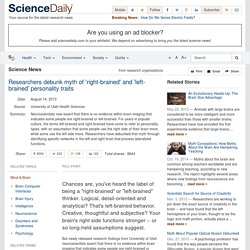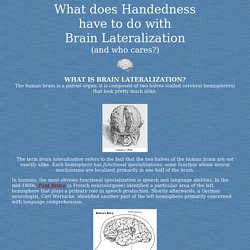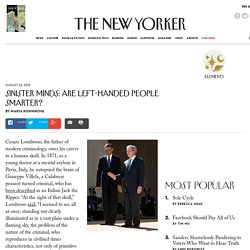Zoom
Trash

Researchers debunk myth of 'right-brained' and 'left-brained' personality traits. Chances are, you've heard the label of being a "right-brained" or "left-brained" thinker.

Logical, detail-oriented and analytical? That's left-brained behavior. Creative, thoughtful and subjective? Your brain's right side functions stronger -- or so long-held assumptions suggest. But newly released research findings from University of Utah neuroscientists assert that there is no evidence within brain imaging that indicates some people are right-brained or left-brained. For years in popular culture, the terms left-brained and right-brained have come to refer to personality types, with an assumption that some people use the right side of their brain more, while some use the left side more.
Following a two-year study, University of Utah researchers have debunked that myth through identifying specific networks in the left and right brain that process lateralized functions. RSA Animate - The Divided Brain. Jill Bolte Taylor's stroke of insight. Lateralization of Function in Cerebral Hemispheres. Biology 202 1998 First Web Reports On Serendip Jonathan Ball One of the major goals of neuroscience is to be able to understand the relationships between the structures of the nervous system and a persons outward behavior.

Often times it is difficult or unethical to directly study the nervous system during a behavior and indirect methods must be used instead. One example of such an indirect method is using a subjects preferred hand to predict which of the two Cerebral Hemispheres is dominant. The are some difficulties with his method of studying lateraliztion of function but if it can be better understood it could have many practical and theoretical implications for the study of neuroscience. The Cerebral Hemispheres are very similar in appearance, but they differ significantly in their structure.
These two discoveries created a watershed of experimentation as other scientists attempted to discover more functional differences between the hemispheres. WWW Sources 3) V.E. 4) Piethish, Paul. The Right Brain vs Left Brain. Right-brained? Left-brained? Take the brain test! Hemispheric Dominance Test determine if your left or right brain hemisphere is dominant. Handedness and Brain Lateralization. The human brain is a paired organ; it is composed of two halves (called cerebral hemispheres) that look pretty much alike.

The term brain lateralization refers to the fact that the two halves of the human brain are not exactly alike. Each hemisphere has functional specializations: some function whose neural mechanisms are localized primarily in one half of the brain. In humans, the most obvious functional specialization is speech and language abilities. In the mid-1800s, Paul Broca (a French neurosurgeon) identified a particular area of the left hemisphere that plays a primary role in speech production. Shortly afterwards, a German neurologist, Carl Wernicke, identified another part of the left hemisphere primarily concerned with language comprehension. Most humans (but not all) have left hemisphere specialization for language abilities.
«Handedness» is a vague term, and can mean many things to many people. Jakt07i1p85.pdf (application/pdf Object) Sinister Minds: Are Left-Handed People Smarter? Cesare Lombroso, the father of modern criminology, owes his career to a human skull.

In 1871, as a young doctor at a mental asylum in Pavia, Italy, he autopsied the brain of Giuseppe Villela, a Calabrese peasant turned criminal, who has been described as an Italian Jack the Ripper. “At the sight of that skull,” Lombroso said, “I seemed to see all at once, standing out clearly illuminated as in a vast plain under a flaming sky, the problem of the nature of the criminal, who reproduces in civilised times characteristics, not only of primitive savages, but of still lower types as far back as the carnivora.” Lombroso would go on to argue that the key to understanding the essence of criminality lay in organic, physical, and constitutional features—each defect being a throwback to a more primitive and bestial psyche. And while his original insight had come from a skull, certain telltale signs, he believed, could be discerned long before an autopsy.
Chief among these was left-handedness.